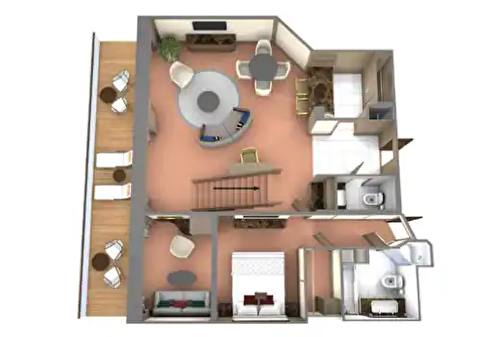Island Cultures from Easter Island to Melanesia
- 18 Mar ‘25
- 38 nights
- Departing from San Antonio (Santiago)
- Seabourn Pursuit
-
Inside price fromCall for price
-
Outside price fromCall for price
-
Balcony price fromCall for price
-
Suite price fromCall for price
YOUR ITINERARY
San Antonio (Santiago), Chile - Robinson Crusoe Island - Selkirk Island, Chile - Selkirk Island, Chile - Easter Island, Chile - Easter Island, Chile - Ducie Island - Henderson Island, Pitcairn - Adamstown, Pitcairn Island - Mangareva, French Polynesia - Anaa, French Polynesia - Papeete, French Polynesia - Raiatea, Society Islands, French Polynesia - Aitutaki - Alofi, Niue - Cross International Dateline - Apia, Upolo - Neiafu - Nuku Hiva, French Polynesia - Vanua Balavu - Yasawa, Islands, Fiji Islands - Ambryn Islands - Pentecost Island - Honiara
This large, modern port serves Chile’s capital, Santiag...
This large, modern port serves Chile’s capital, Santiago, a city with Spanish colonial charm and a vivacious spirit. Encircled by the Andes and the Coastal Range, Santiago is centered around the Plaza de Armas, with several of the city’s landmarks: the 18th-century Metropolitan Cathedral the Palacio de la Real Audencia from 1808, the City Hall and the National Museum of History. North of San Antonio lie the picturesque old port and university town of Valparaíso and the colorful seaside resort of Viña del Mar. In between the coast and the capital are valleys filled with some of Chile’s most famous wineries, all inviting you to come and taste.
The southeastern-most point in the Polynesian Triangle, tiny Eas...
The southeastern-most point in the Polynesian Triangle, tiny Easter Island in the South Pacific is one of the most remote places on earth. Even more oddly, it belongs to Chile, which lies 3,700 miles away over the eastern horizon. In fact, a large slice of the island is Chile’s Rapa Nui National Park, preserving the sculptural heritage of the indigenous Rapa Nui people, whose ancestors carved the huge human effigies called moai that give the island its renown and earned it UNESCO World Heritage Site status. These stylized sculptures stand on the slopes of the island, gazing implacably out to sea, often on stone platforms called ahu. They were apparently carved between the 13th and 16th centuries, for reasons that are debated. But the enigmatic effigies, the dramatic volcanic landscape, the Rapa Nui people themselves and the sheer isolation of the island combine to draw visitors from every corner of the globe to this speck in the world’s largest ocean.
The southeastern-most point in the Polynesian Triangle, tiny ...
The southeastern-most point in the Polynesian Triangle, tiny Easter Island in the South Pacific is one of the most remote places on earth. Even more oddly, it belongs to Chile, which lies 3,700 miles away over the eastern horizon. In fact, a large slice of the island is Chile’s Rapa Nui National Park, preserving the sculptural heritage of the indigenous Rapa Nui people, whose ancestors carved the huge human effigies called moai that give the island its renown and earned it UNESCO World Heritage Site status. These stylized sculptures stand on the slopes of the island, gazing implacably out to sea, often on stone platforms called ahu. They were apparently carved between the 13th and 16th centuries, for reasons that are debated. But the enigmatic effigies, the dramatic volcanic landscape, the Rapa Nui people themselves and the sheer isolation of the island combine to draw visitors from every corner of the globe to this speck in the world’s largest ocean.
Adamstown is the capital of, and the only settlement on...
Adamstown is the capital of, and the only settlement on, the Pitcairn Islands.
The islands of French Polynesia are acclaimed as the most ...
The islands of French Polynesia are acclaimed as the most beautiful in the South Pacific. Tahiti is the largest of the Polynesian islands and home to the capital city of Papeete, a delightful blend of cultures. Papeete, meaning the “water basket,” was once a gathering place where Tahitians came to fill their calabashes with fresh water. Today, it is the gateway to the country, and boasts romantic resorts, fine dining, vibrant markets, pearl shops, and boutiques. Tahiti’s mountainous interior is adorned with deep valleys and scenic waterfalls, while the rugged coastal lands are home to fields of tropical flowers, and glorious white and black sand beaches.
The second-largest of the Society Islands is practically tw...
The second-largest of the Society Islands is practically twinned with its neighbor Taha’a. Actually they are connected by a reef in the same lagoon and may have been one island in the past. The main town, Uturoa is where most of the population lives. It’s lively, although no competition for Tahiti. Called the Sacred Island, Raiatea’s name means “bright sky,” and it was probably the first human community in the islands. The ancient sacred site of Taputapuatea is a UNESCO World Heritage Site, and may have been the place from which Polynesian migrations to Hawaii, the Cook Islands, New Zealand and the rest of the South Pacific started. Although less touristed than Tahiti, caring for visitors has grown in importance. Agriculture is mainly given over to coconuts, pineapples and vanilla. Vanilla orchids are hand-pollinated, since Raiatea has no insect pollinators for vanilla blossoms. South Seas pearls are farmed in the lagoon in various colors. A hike up Mt. Tapioi rewards with stunning views of the lagoon and sea, and tall Bora Bora on the far horizon. Another favorite hike leads to the island’s three waterfalls. The tallest peak, Mt. Temehani, is the place to look for the unique, five-petaled Tiare Apetahi flowers that grow nowhere else. The lagoon is dotted with tiny motus, which are mostly coral sand beach, and are popular for castaway swimming and snorkeling adventures.
Alofi is the capital of the Pacific Ocean island nation...
Alofi is the capital of the Pacific Ocean island nation of Niue. With a population of 597 in 2017, Alofi has the distinction of being the second smallest national capital city in terms of population. It consists of the two villages: Alofi North and Alofi South where the government headquarters are located.
A total of sixteen islands comprise the Samoas, considered ...
A total of sixteen islands comprise the Samoas, considered to be the heart of Polynesia. It was from these islands that early Polynesians sailed to populate other Pacific Islands. Today this chain of islands is divided into two political units – the U.S. Territory of American Samoa and the independent country of Western Samoa. Much of the charm of the Samoas lies in the simple village life and the friendly people, combined with a striking landscape of soaring mountain peaks, rugged coastlines, white sandy beaches and tropical rainforests rich in flowering plants. Western Samoa consists of a total of nine islands with the two main ones, Savi’i and Upolo, separated by a narrow strait. The country’s capital Apia, resembling an old South Seas port during the early trading days, perches on the north coast of Upolo. Colonial-style wooden buildings and churches line the tree-shaded main street that curves around the harbor. The primary attractions include Parliament House, the village green, Independence Monument and the former home of Robert Louis Stevenson, now the residence of Western Samoa’s head of state. A trip around the island passes mile after mile of stunning landscape, interspersed with tumbling waterfalls, breathtaking views, tiny villages, and coconut and cocoa plantations.
vava’u is really a group of islands in the northern pa...
vava’u is really a group of islands in the northern part of Tonga, consisting of the large island of Utu Vava’u and a cluster of some forty smaller islands. Utu Vava’u is blessed with one of the most protected harbors in the South Pacific, dubbed the Port of Refuge by a grateful early mariner, making it a favorite of yachtsmen. The capital of Neiafu is located on that harbor. The islands are all coral, either raised limestone or atolls. Polynesian mythology insists that the land was created by the god Maui, who hooked the sea bottom while fishing and raised it up. Gazing at the islands popping above the crystal-clear, azure tinted seas, it seems a logical conclusion. The town of Neiafu reflects the laid-back Polynesian spirit of Tonga. Its white church is central to the town. If you are lucky enough to be there when the choir is singing you will hear the clear harmonic blend that has made the Polynesians renowned as singers throughout the world. Activities center on the clear sea and coral reefs, with snorkeling and fishing among the most popular. The fjord-like Pulepulekai Channel is a great place for a lagoon cruise. The island also boasts Ene’io, Tonga’s only Botanical Gardens, and farms producing pineapples and world-famous vanilla. The island does have a progressive coconut products company that produces oil, soaps, cheese, and various other products in an eco-friendly, sustainable way.
The stunningly beautiful island of Nuku Hiva is the larges...
The stunningly beautiful island of Nuku Hiva is the largest of the Marquesas Islands of French Polynesia, and an overseas territory of France. The first people to arrive here came from Micronesia over 2000 years ago, and later colonized Tahiti, Hawaii, the Cook Islands and New Zealand. The legend has it that Ono, the god of creation, promised his wife he would build a house in one day, so he gathered together land and created these islands, all named after parts of the house. Nuku Hiva is the roof of Ono’s house. Its volcanic origins are responsible for the dramatic scenery and vast natural harbor that exist due to the partial collapse of a volcano’s caldera.
The Solomon Islands is a sovereign nation consisti...
The Solomon Islands is a sovereign nation consisting of multiple island groups, scattered in the South Pacific east of Papua New Guinea. Its capital is Honiara, on the island of Guadalcanal. Many of the outlying islands in the nation are relatively untouched, but Honiara is a busier hub of international commerce. The islands’ recent history is scarred by the desperate battles fought between the Japanese and American forces during World War II. In 1942, the Japanese launched their last great land offensive in the islands, which culminated in the Battle of Henderson Field fought at Honiara. Of the estimated 36,000 Japanese troops on Guadalcanal at the beginning, only 1,000 survived, the rest having either been killed directly, or succumbed to disease and starvation. Ghostly evidence of this horrific warfare dots the island, and it is memorialized at the American Memorial overlooking the town and at a smaller Solomons Peace Memorial erected by the Japanese outside the city. On a lighter note, traditional arts and crafts are on display at the National Museum, which also boasts a display of eight traditional Melanesian houses from various parts of the country. Behind the museum is a cultural center. Above town there is a pleasant botanical garden, and the bustling Central Market is a great place to get a feel for everyday life in Honiara. Although English is the official language, only a small percentage of Solomonese speak it. The common language is Pijin.
YOUR SHIP - The Seabourn Pursuit
Construction for Seabourn Pursuit began in fall 2020 during a ceremony in San Giorgo di Nogare, Italy, and the build process is well underway. The ship is scheduled for delivery in 2023, with its sister ship, Seabourn Venture, slated for delivery in 2022.
Seabourn Pursuit is the second Seabourn expedition ship slated to launch in 2023. Both Seabourn Pursuit and sister ship Seabourn Venture are designed and built for diverse environments to PC6 Polar Class standards and include modern hardware and technology that will extend the ships’ global deployment and capabilities. Each will carry two custom-built submarines, 24 Zodiacs, kayaks, and a 26-person expert expedition team whose role is to engage guests throughout each voyage.
The ship then continues onward by exploring the waters and landscapes of Greenland, Iceland and Norway throughout the spring and early summer, in some instances retracing the path of the Vikings to the frontier town of Tromsø while carving its way through the inside passage of the Norwegian fjords along the way.
Description
Construction for Seabourn Pursuit began in fall 2020 during a ceremony in San Giorgo di Nogare, Italy, and the build process is well underway. The ship is scheduled for delivery in 2023, with its sister ship, Seabourn Venture, slated for delivery in 2022.
Seabourn Pursuit is the second Seabourn expedition ship slated to launch in 2023. Both Seabourn Pursuit and sister ship Seabourn Venture are designed and built for diverse environments to PC6 Polar Class standards and include modern hardware and technology that will extend the ships’ global deployment and capabilities. Each will carry two custom-built submarines, 24 Zodiacs, kayaks, and a 26-person expert expedition team whose role is to engage guests throughout each voyage.
The ship then continues onward by exploring the waters and landscapes of Greenland, Iceland and Norway throughout the spring and early summer, in some instances retracing the path of the Vikings to the frontier town of Tromsø while carving its way through the inside passage of the Norwegian fjords along the way.
STATEROOMS

suite


